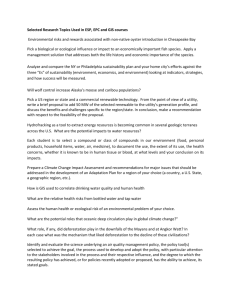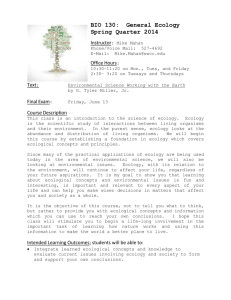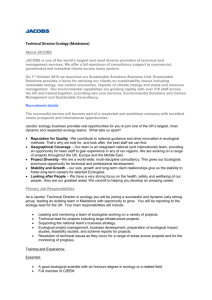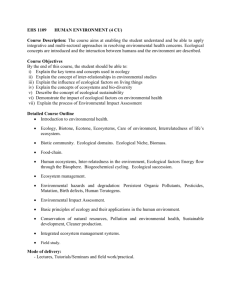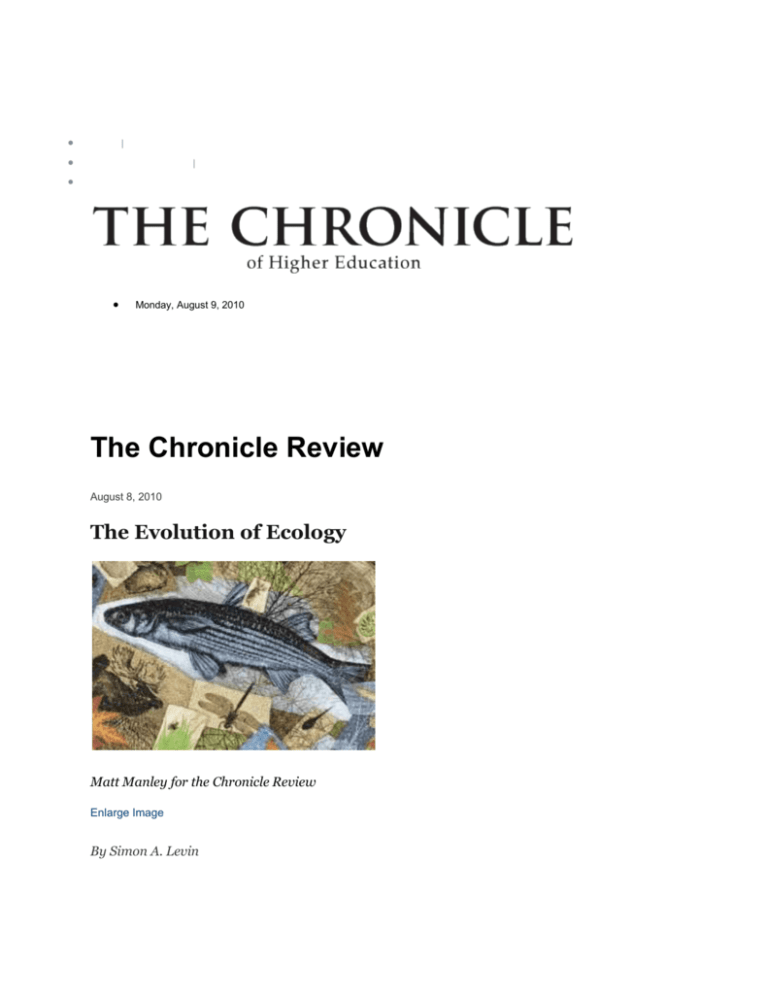
= Premium Content
Log In |
Create a Free Account |
Subscribe Now
Monday, August 9, 2010
The Chronicle Review
August 8, 2010
The Evolution of Ecology
Matt Manley for the Chronicle Review
Enlarge Image
By Simon A. Levin
The scientific discipline of ecology is dynamic, steeped in historical tradition but adapting to its
changing environment and building its own ecological network of interactions with other disciplines.
What is ecology, what have some of its high points been, and, most important, where is it going? All
of us on planet earth today, not just scientists, need to know the answers. Society has become
increasingly aware that we are losing crucial parts of our ecosystem, and that the activities of human
beings are threatening the sustainability of the biosphere as a life-support system for humanity. As I
have written elsewhere, "Ecology, the unifying science in integrating knowledge of life on our planet,
has become the essential science in learning how to preserve it."
The word "ecology" did not exist when Charles Darwin published his journal, The Voyage of the
Beagle, but one can argue that Darwin's account launched ecology as a discipline. Darwin began by
reminding his readers that he had previously published volumes on coral reefs, volcanic islands, and
the geology of South America. His integration of the physical and biological dimensions of the places
where the Beagle stopped, complemented by influential contemporary work by the English naturalist
Alfred Russel Wallace, defined a new and synthetic way of looking at nature—in which the patterns
characteristic of particular regions found explanation in a unifying, dynamic framework. The term
"oekologie" came later, the inspiration of the German scientist and physician Ernst Haeckel, but it
was the theories of Darwin and Wallace that created the rich understanding that allowed the new
approach to rapidly become a science.
Thus ecology sprang from a marriage between geology and natural history, rooted in observation, but
answering a need for a conceptual framework. From its early roots, it became increasingly rigorous
and quantitative, and a century later provided the natural discipline for responding to the
environmental challenges highlighted by Rachel Carson, Paul Ehrlich, and others. Ecology and
environmental studies made for a natural partnership, since the scientific study of ecology provided
the tools for meeting many of the emerging environmental threats, while those threats in turn
provided new stimuli for ecological investigations.
Fields like ecotoxicology, which studies the fate, transport, and effects of chemicals in the
environment, and conservation biology, which seeks to preserve biodiversity, were spawned, closely
linked to ecology, but much more applied in focus. The synergy among the disciplines was
constructive, but it also tended to blur the distinctions in the public eye between the science of
ecology and the application of ecological principles to the management of natural resources. Ecology
is a scientific discipline, like physics or molecular biology, whose practitioners are driven by the
search for patterns and process in nature. Their findings can inform political decisions about
resource use, pollution, climate change, and other environmental issues; but advocacy regarding
decisions about our environmental priorities is outside the discipline of ecology. Still, for many
people, "ecologist" became a term applied to anyone who wanted to save the planet, or selected parts
of it, which made no more sense than calling someone who marvels at the night sky an astronomer.
The application of ecological principles to environmental problems did not suddenly occur with the
publication of Silent Spring in 1962; that, like ecology as a whole, had much older roots. The fishing
industry provided an early case study nearly a century ago, when the distinguished Italian biologist
Umberto D'Ancona puzzled over the causes of fluctuations in the fisheries of the Adriatic.
Fortunately, D'Ancona was to marry the daughter of the great Italian mathematician, Vito Volterra,
who had become interested in applying his skills in formal mathematics to the study of biological and
social systems. Volterra is famous among mathematicians for his contributions to the theory of
functionals and integral equations, but is even better and more widely known for the equations he
and Alfred Lotka derived independently to describe the dynamics of interacting species. Volterra
showed that the simplest of ecosystems, involving only a predator species and its prey, could go
through endless cycles of changing numbers of individuals as the growth of the prey population
produced a similar increase in the predator; that in turn led to a decline in the prey, followed by a
decline in the predator, bringing both populations full circle.
Nevertheless, the greatest contribution Volterra made was not in his specific equations, but rather in
the heterodox idea that sophisticated mathematical methods could be used to understand the
dynamics of natural systems. The equations of Volterra and Lotka are taught today in virtually every
first course in ecology, and the application of mathematical and computational methods has
expanded into every branch of ecology, giving us, for example, integrated models that deal with the
interaction between a changing climate and the growth of forests and other vegetation. The influence
of mathematics and computation in biology as a whole has also expanded in the last decade, and
fields like systems biology (the study of the interplay among the parts of biological systems, like
molecular or metabolic systems) and computational biology (with its use of mathematics and
computation) have become essential parts of any modern biology department. It should not be lost,
however, that through the contributions of Volterra and those who followed in his footsteps, ecology was the first subdiscipline of
biology to become deeply quantitative.
That is important, because fisheries and forests are perhaps the most important cases of natural
populations exploited by human beings for food, fiber, and fuel; they are examples of what today are
termed "ecosystem goods and services." Managing fisheries raises unique challenges as compared
with agriculture, or even to forests, because so much of the ocean's resources are beyond the control
of the manager. The economic importance of fisheries, and the importance of managing them to
optimize the benefits human beings derive from them, has led to a rich theoretical and applied
literature, with some successes and many failures. Marine fisheries have always provided crucial
sustenance to human beings, but many of the most favored stocks have collapsed because of
overfishing. That has led to recognition that we need to pay more attention to the insights of
D'Ancona and Volterra, and to manage fisheries as components of complex ecosystems rather than
as independent entities. Even today, most management efforts are focused on particular species, like
salmon, for many of the same reasons that the Endangered Species Act refers to individual species
and populations; such specificity may reflect the constituencies that salmon or trout, or pandas or
tigers, enjoy—and more generally simplifies management. There is increasing recognition, however,
that any species is part of a larger network of species, competing for common resources, and that
such interconnections cannot be ignored any more than economic policy makers in the United States
can ignore the problems of Iceland or Greece.
Fisheries provided only one early and important example of the application of mathematical and
ecological perspectives to human welfare. Two other examples come from epidemiology and
demography. Infectious diseases involve a fundamental ecological interaction, that between a
parasite and its host. Parasite-host systems are similar in many ways to predator-prey systems, and
hence exhibit the same potential for oscillation that Volterra demonstrated. Such oscillatory
dynamics are only too familiar to us, for example, in the seasonal fluctuations of influenza cases.
There is a difference, however, in that parasites live within hosts, and so may die when their hosts die
unless they can be transmitted to other hosts. From an evolutionary perspective, that suggests that
parasite-host systems will evolve to favor less virulent parasites, because the most virulent strains
kill their hosts before they can spread to other hosts; there is considerable evidence to support that
concept. One remarkable example involves documentation by the virologist Frank J. Fenner,
beginning in the 1940s and 50s, of the evolution of reduced virulence in the myxoma virus in
Australia when it was introduced to control the European rabbit; again an ecological perspective
proved crucial to successful management of the plague of rabbits.
Demography provided perhaps the earliest example of the application of both ecological and
mathematical thinking to problems of natural populations. Demographers like John Graunt, as early
as the 17th century, used sophisticated mathematical methods to project human population growth,
building on methods that were known for centuries before, tracing back to the mathematician known
as Fibonacci. Graunt also recognized that the observed growth rates for the population of London
were not sustainable, and could not have been in place historically, or else the population of London
would have been much larger than it was. In the early 18th century, Thomas Malthus, in An Essay on
the Principle of Population, emphasized that essentially ecological factors, like famine and disease,
ultimately restrain the growth of population; that insight was incorporated into a number of
mathematical modifications of the basic equations of exponential growth. The science of
demography has evolved an elegant mathematical underpinning since then, and its evolutionary
dimension—life-history theory, which seeks to elucidate the impact of natural selection on the life
cycle, is a cornerstone of ecological theory.
Of course, because of the implications for economic growth, these issues will always remain
controversial. In 1968, Ehrlich's The Population Bomb warned about the devastating possibilities,
like mass starvation, of unlimited population growth. That has led to spirited and often rancorous
debate about the inevitability of population limitation and the potential for technology to fill the
needs of a world population growing without limits. To an ecologist, it seems evident that earth's
resources are ultimately finite, and that populations cannot grow without bound. Where those limits
are, and how large a population the world can sustain, is the essence of the debate.
And where are we now? The writings of Darwin and Wallace clearly influenced the development of
ecology; but perhaps even more fundamentally, they also launched the field of evolution. Natural
selection is just one of many factors influencing evolutionary change, but it is the most important in
providing a link to the ecological context within which organisms exist and interact. When Darwin
developed his theories, our understanding of the genetic mechanisms underlying evolution was in its
infancy. In the early parts of the 20th century, the theory of population genetics developed rapidly, in
close partnership with animal and plant breeding, and with a strong mathematical foundation. Then
in the middle of the 20th century, unification took place between population genetics and
evolutionary theory. The Modern Synthesis provided a framework for a similar unification with
ecological studies, but that step had to wait as genetics turned to developing a deeper understanding
of the molecular details of genetic control of basic aspects such as development and physiology. As
that foundation has become solidified, increased attention has become directed to systems biology—
how the complex assemblage of genetic circuits cooperate to produce and run the organism, how the
organism interacts with other organisms and its environment, and how whole communities and
ecosystems emerge from evolutionary processes at the microscopic level. The collection of vast
amounts of "metagenomic" information, involving genetic material of many species in the same
environments, holds great potential for allowing us to extend evolutionary studies beyond individual
species, to the complex ecosystems in which fish, pandas, and tigers live.
Perhaps the scientist who most influenced the development of ecology in the last century was the
limnologist G. Evelyn Hutchinson, who studied inland waters but wrote trenchantly on almost every
aspect of ecology, providing an evolutionary context for understanding ecological characteristics and
ecosystem patterns. However, although the unification of the multiple levels of organization may
have been clear in Hutchinson's mind, three or four decades ago the subjects of population biology
and ecosystems science were worlds apart intellectually, and leaders of both struggled to find ways to
communicate with each other. That chasm has narrowed dramatically, as population biologists have
begun to emphasize the importance of coevolution—how evolving populations influence one
another—and niche construction—how organisms shape their own ecological roles and those of other
organisms. Ecosystem scientists now strive to understand patterns of nutrient use and nutrient
cycling within an evolutionary framework, epidemiologists focus on the coevolution of hosts and
parasites and seek understanding of the evolutionary history of viruses and bacteria, and rapid
advances in genomics and metagenomics raise challenges for understanding their relevance for the
distribution and abundance of organisms in their natural environments.
The scientific discipline of ecology has thus been, in some sense, a key node in an ecology of scientific
disciplines. From its roots in natural history, it has built partnerships with botany and zoology; with
geology and paleontology; with mathematics; and with evolutionary studies, from molecular biology
to population genetics and development. It has not ignored physics and engineering along the way,
in its need to understand the mechanics of how animals and plants grow and move, or how they
capture energy and resist stress—why, for example, trees are shaped the way they are. Ecologists
make their living by recognizing the interconnectedness of different parts, and different disciplines.
But what is missing in the story to this point are strong links to the social and policy sciences, and to
the humanities. Those dimensions have not been entirely missing in the past. Some conservation
ecologists have recognized the importance of making clear that biological diversity must be
preserved not just for its own sake, but because it underlies a wide range of goods and services that
are essential to all life on our planet, including food, fiber, fuel, and pharmaceuticals. We also receive
indirect benefits from pollination, from plants that moderate climate change by taking up carbon
dioxide, and from habitats that sequester nutrients and toxins; all of those are active topics of
ecological investigation today.
What we must do now, however, is to unify science and the social sciences and humanities further in
the service of preserving the earth. That challenge is stretching ecology in new directions. To sustain
the planet, we must be able to protect the goods and services ecosystems provide, and that requires
knowing what they mean to us. In large part, that is the domain of economics. Bringing ecology and
economics together is not new, and most land-grant universities have strong departments of
agricultural and resource economics that deal with the economics of agriculture, fisheries, and
forests. But new dimensions in environmental and ecological economics have been developing
rapidly, focusing on questions about the value of whole ecosystems, about the optimal design of
nature reserves, and about how to manage public goods. Broadly understood, environmental public
goods include the air we breathe and the water we drink, the fish we catch and the lakes and oceans
that sustain them, as well as the antibiotics that have contributed so much to the advancement of
medical care.
Still, cooperation for the common good is vulnerable to cheaters who can derive benefits without
paying their fair share, and it cannot be sustained without new mechanisms and institutions. Our
political leaders have already begun to recognize that in dealing with the world's interconnected
financial systems; it applies with at least equal force to our environment. Solutions to the great
environmental challenges we face will require deep partnerships between ecologists, economists, and
other social scientists.
Scientists will also need to work with humanists and ethicists, as we deal with the core problems of
intergenerational and intragenerational equity, and the powerful role of social norms in shaping
individual behaviors. How much of our resources is it equitable for us to consume today, and how
much should we leave for future generations? How do we deal with the growing inequity in the
distribution of wealth within our populations today, and the implications for access to natural
resources?
As with the partnerships ecology has forged in the past, the benefits are likely to be mutual; indeed,
months before the current financial crisis, my co-authors and I suggested in an article in Nature that
an ecological perspective would be helpful in dealing with issues of systemic risk in the banking
system because, we argued, the system was too interconnected and vulnerable to contagious spread
of disturbances due, for example, to the subprime-mortgage mess. The banking system, just like the
economy, is a kind of ecological system, and it should be managed as one.
Ecology views biological systems as wholes, not as independent parts, while seeking to elucidate how
the wholes emerge from and affect the parts. Increasingly, such a holistic perspective, rechristened at
places like the Santa Fe Institute as "the theory of complex adaptive systems," has informed
understanding and improved management of economic and financial systems, social systems,
complex materials, and even physiology and medicine. Essentially, that means little more than
taking an ecological approach to such systems.
Simon A. Levin is a professor of biology at Princeton University. He is editor of The Princeton
Guide to Ecology (Princeton University Press, 2009).
1. wartburg - August 09, 2010 at 11:20 am
Some might argue that the ecological approach encompasses departments of religious studies. Darwin is
God.
Copyright 2010. All rights reserved.




